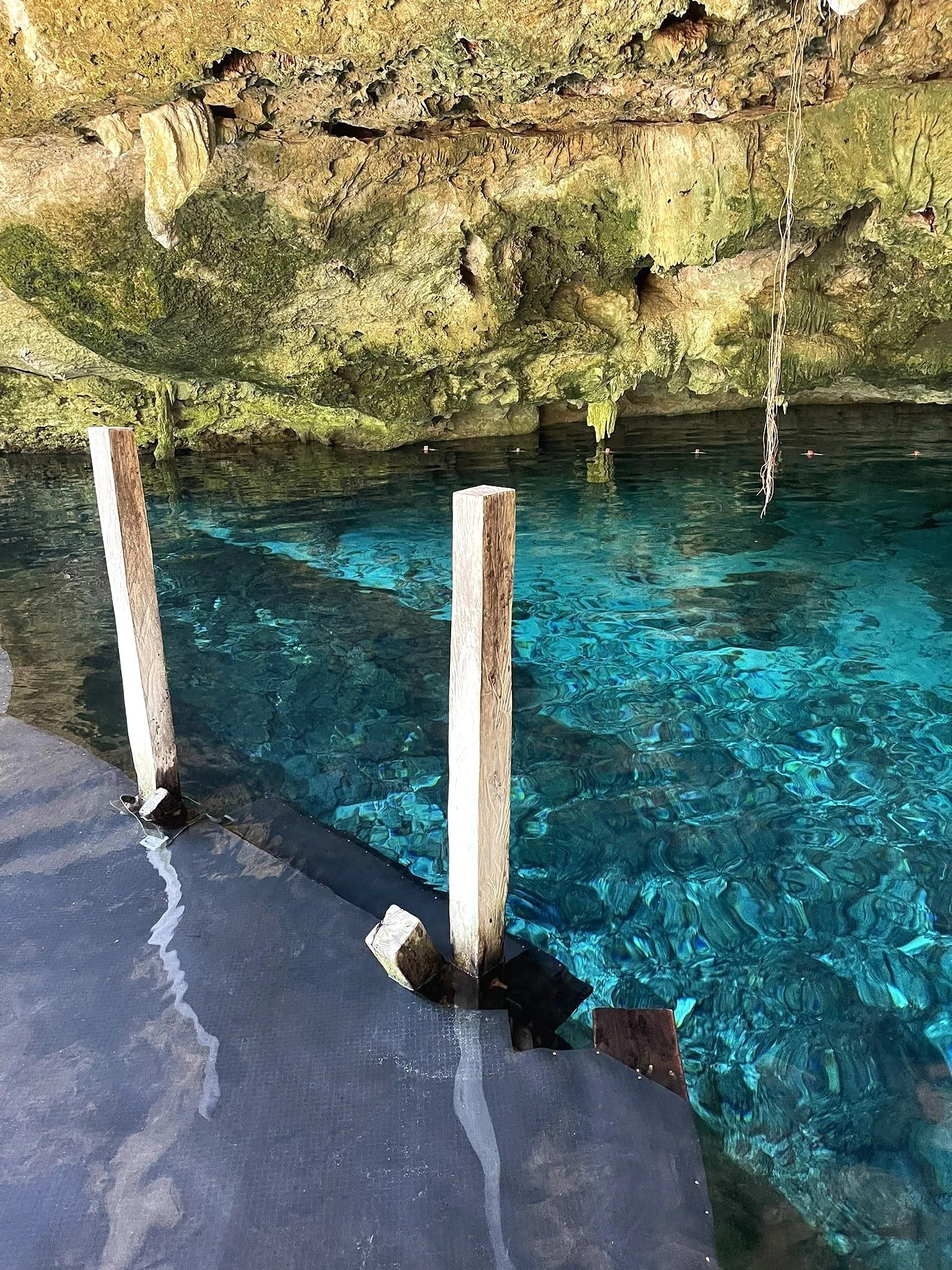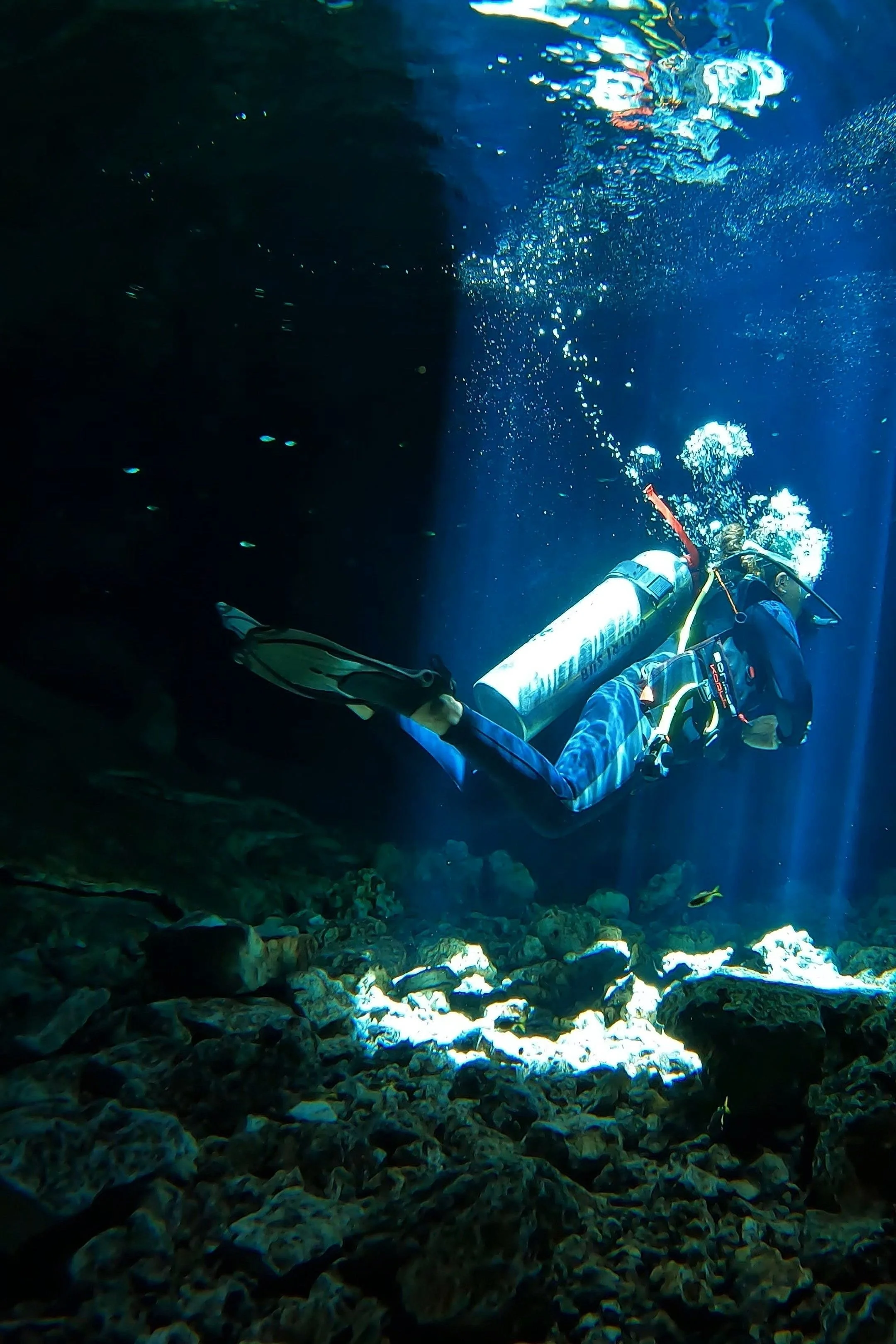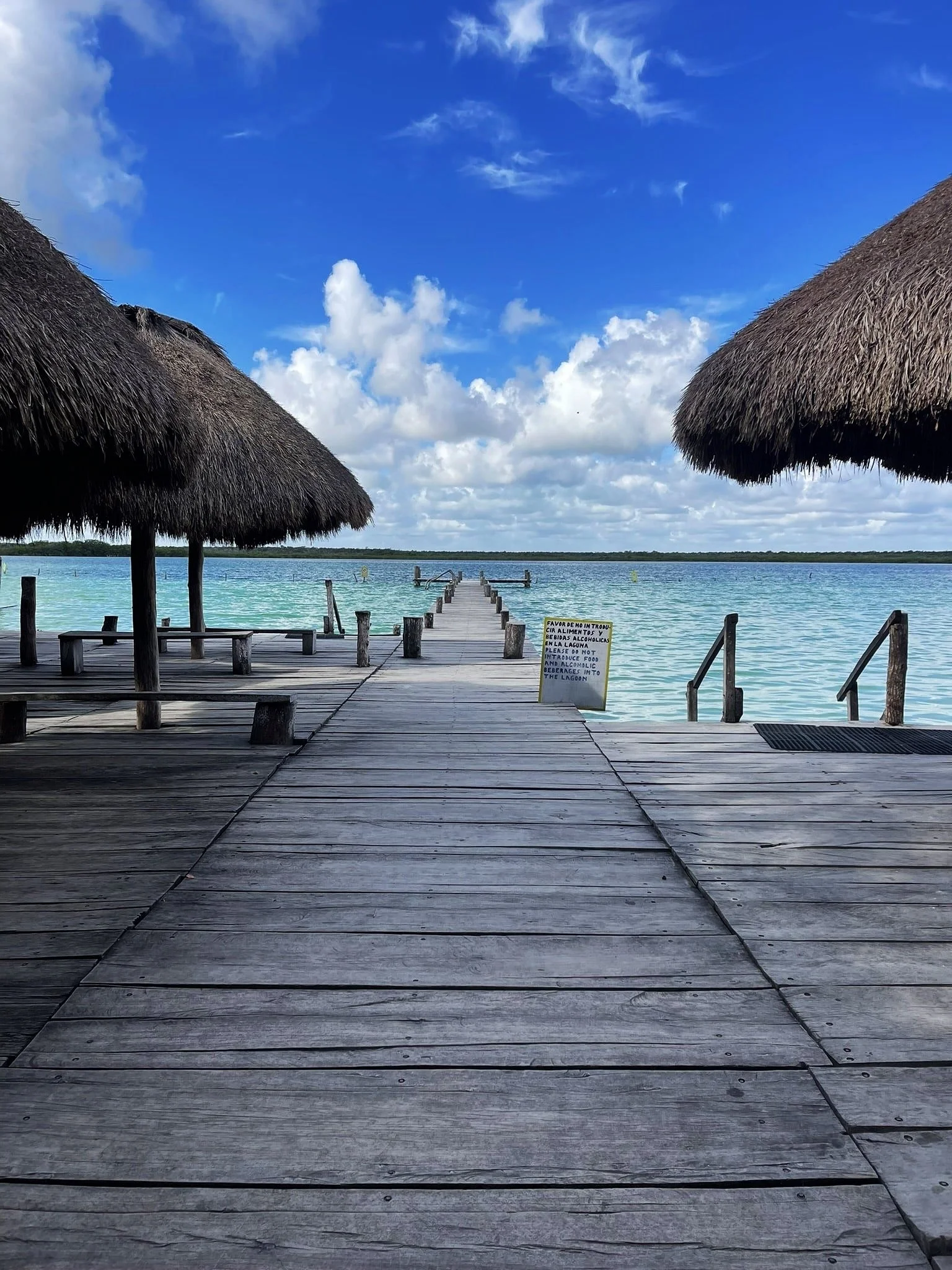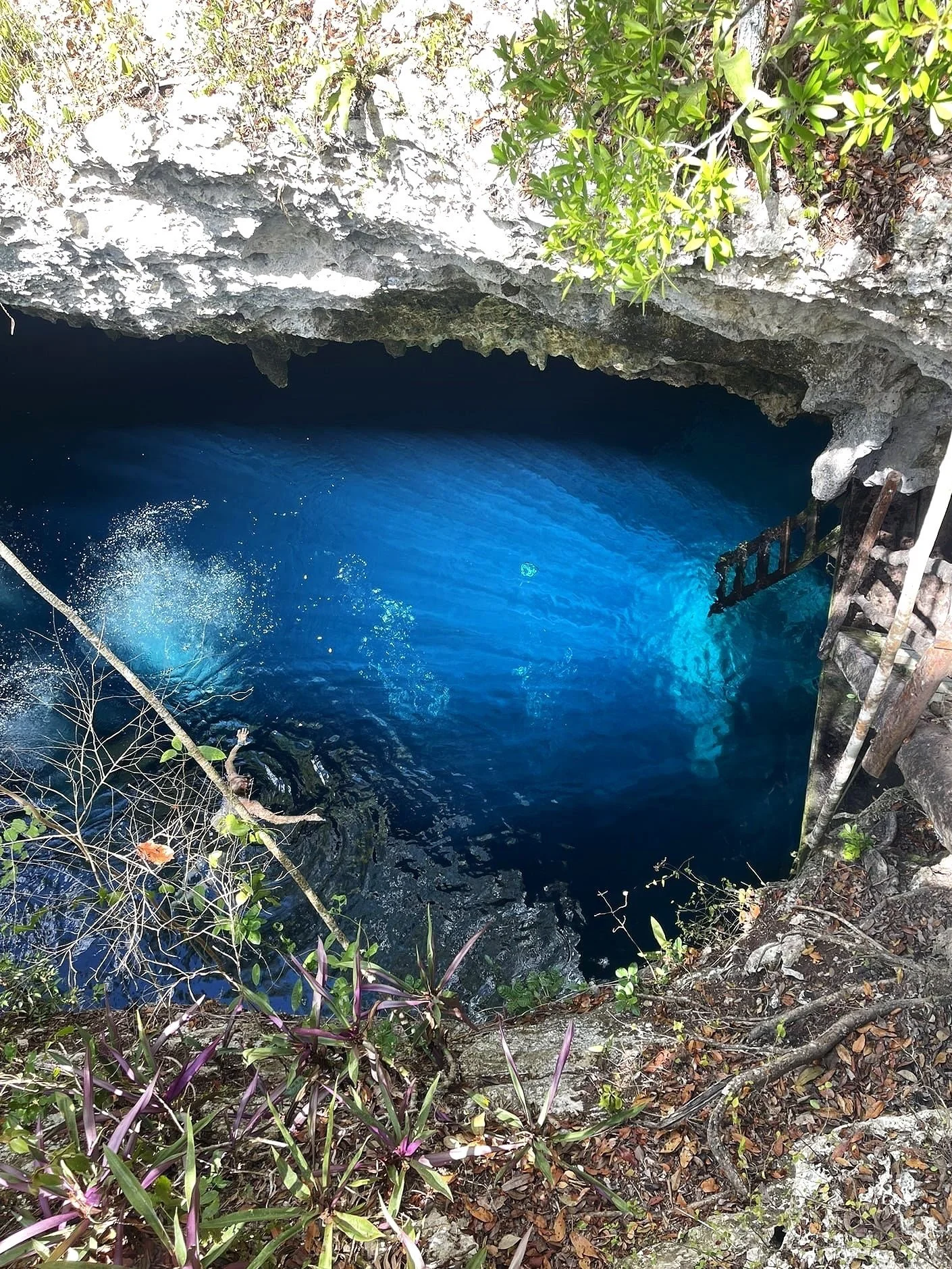Uncovering The Best Cenotes In Tulum
Exploring a cenote is an essential experience when visiting Tulum. With over 100 cenotes to choose from, deciding which ones to visit can feel nearly impossible. After spending a month in this bohemian beach town, I have put together a guide to the best cenote experiences in Tulum! Let’s jump into it…
Disclaimer: This post contains affiliate links. If you click through and make a purchase, my blog may receive a commission at no additional cost to you.
The Best Cenotes Experience(s) in tulum
#1: Dive Into A Cenote (Literally)
Tulum is booming with cenotes, having over 100 scattered throughout the town. Initially, I was not too keen on paying 250-400 pesos just to swim in what essentially is a hole filled with water. However, while researching which cenotes might be worth visiting during my month in Tulum, I stumbled across the idea of scuba diving in a cenote. THIS seemed like something worth paying for. It transformed that hole filled with water into an opportunity to explore the true beauty of a cenote: stalagmites, stalactites, secret caverns, and underwater life that has existed for millions of years! It promised a priceless experience.
Sustainable Tourism: Cenotes contain fragile ecosystems that can be easily disrupted by touching, kicking, or removing formations, and even by leaving waste behind. Please travel respectfully so generations to come can continue to explore and enjoy these natural wonders.
The Cenotes I dove in…
El Pit
I chose to dive in El Pit because it was the cenote that scared me the most. You essentially scuba dive 30-40 meters down into a pit of darkness, with sections appearing blurry from the saltwater and freshwater mixing. I also wanted to see a hydrogen sulfide cloud—an eerie green cloud-like shape that forms closer to the bottom half of the pit.
Dos Ojos
I chose Dos Ojos because I wanted something entirely different from El Pit. This cenote system allows you to swim through caverns and smaller openings within the cave system, providing a unique and contrasting experience.
My Experience…
As mentioned, this was an epic adventure, unlike anything I had ever experienced in my life. Our guide from The Cenote Guy, Sebastian, was incredibly informative throughout the trip. He explained the history and significance of cenotes, and how new ones are formed. Before each dive, he would guide us to the cenote for photo opportunities and then gather us around a large banner detailing the cenote's features. He carefully explained what we would encounter during the dive and how he would communicate important details underwater. After gearing up, we would then descend into the cenotes.
The trip cost 160 USD, which covered transport from Tulum or Playa Del Carmen, a certified guide, full gear (including weights, flashlights, and tanks), snacks, lunch, water, and a guarantee of a maximum group size of 4 people. An additional 33 USD for entrance fees into the cenotes was not included in the initial cost.
For more information on scuba diving a cenote, head here!
#2: Visit The Cenote at the Stunning Laguna de Ka’an Luum
Laguna de Laguna de Ka’an Luum is a crystal-clear lagoon with a massive deep blue cenote in the middle. This spot is epic and like no other cenote experience, making it #2 on the list of the best cenotes in Tulum.
At Laguna de Ka’an Luum, you will discover swings, hammocks, photo spots, paddleboards, and a viewing tower that overlooks the lagoon. As you enter, a long wooden boardwalk winds through the jungle, guiding you to an up-close view of the expansive, deep blue cenote at its center. The area is rich with wildlife, including numerous birds and butterflies fluttering around the lagoon, adding to its natural charm and beauty.
Note: Swimming is not permitted in the center cenote area.
Entry to Laguna de Ka’an Luum is 300 pesos, and a shower is required before entering. Food and beverages are available for purchase, along with nearby bathrooms.
I arrived early at around 9:00 AM and spent 3-4 hours there. It was less crowded at this time, with only about 30-50 people, making it an ideal visit. For those who prefer fewer crowds, mornings and early afternoons are the best times to visit, although it generally does not get too crowded here.
There are other lagoon options available, such as the Sian Ka'an Biosphere Reserve, though I did not visit it myself due to the higher cost—around 1,000 pesos to float down the lagoon there, which is approximately 60 USD.
#3: Best Cenotes In Tulum For A Day Out
If you are looking to simply swim and snorkel in a cenote and enjoy your day, there are plenty of options available. You can either venture to one on your own via motorbike or join a group tour!
A few of my top options for those looking to swim on their own…
Cenote Xunaan-Ha: 200 pesos
Nic Te Ha: 100 pesos
Cenote Escondido: 150 pesos
Cenote Cristal: 150 pesos
Cenote Corazón del Paraíso: 200 pesos
For those travelers seeking a more relaxed cenote experience, consider checking out Vesica Tulum, a restaurant located on a cenote.
Looking for some party vibes? You can make a reservation at Neek Tulum by sending them a message on Instagram. Neek Tulum is another hip restaurant located on a lagoon (not exactly a cenote, but worth mentioning) that features cocktails, live music, and exquisite gastronomy. They often host events and even allow pets! Check out their Instagram to get a better sense of their vibe!
Head here if you are looking for the best group tour options!
General Information: Tulum
Best Time to Visit:
The best time to visit Tulum for optimal weather and minimal seaweed is from November to April. However, the best deals on accommodations and other expenses are during the low season, which is the opposite of these months.
High Season: December - April
Seaweed Season: April - October
Hurricane Season: June - October
Travel Tip: Tulum is prone to frequent power outages, especially during the windy and rainy hurricane season. I experienced them regularly during my time here.
How to Get to Tulum:
FLYING:
Tulum has a relatively new international airport (TQO), situated approximately 40 minutes from La Veleta and 45 minutes from Aldea Zama and the Tulum Beach/Hotel zone.
To book flights, I suggest looking on Kiwi.com or Skyscanner.com for the best flight deals. Unlike Google Flights, Kiwi and Skyscanner include regional flights in their search results.
Note: Taxi fares from the airport into Tulum can be pricey.
PRIVATE TAXI:
A private taxi is always an option but can be quite pricey. From Playa del Carmen, I was quoted anywhere from 1200-2000 pesos (70-120 USD) by drivers.
ADO BUS:
ADO is the main Mexican bus company throughout the country, and most routes are safe for tourists. You can take an ADO bus from nearly anywhere else in Mexico to get to Tulum. The best routes are from Cancun and Playa del Carmen. Prices vary depending on the time of year and time of departure. My bus from Playa del Carmen was 120 Pesos (around 7 USD) and only took a couple of hours.
COLECTIVO:
A Colectivo is a shared van with other people heading to the same destination you are. They are most often driven by locals and are the best form of transportation for backpackers and travelers with less luggage.
The Colectivo from Playa del Carmen to Tulum can be found under Highway #307, (below Juarez Avenue) near Chedraui. Find the Google Maps location here.
The Colectivo ride costs a little above or below 40 pesos and stops near the Tulum Ruins and the ADO bus station. They do not always stop at Tulum Ruins, so if this is your destination, be sure to tell the driver ahead of time and be on the lookout during your drive. You will need to either walk or hire an additional taxi to get to your accommodation.
Note: Colectivos can be small, cramped, and timely. Sometimes they will wait for a full van before departing. They do not always have working air conditioning. If you have a lot of bags or a large bag, they may turn you down for more passengers instead (more money for the driver).
Mode of Transport in Tulum:
Options: Taxi, bicycle, motorbike/ATV. If you are going to be here long term, your best option is to purchase one of these outright because of how overpriced rentals are here. Tulum is not very walkable, with everything being spread out and still under development. Each section of Tulum, such as Aldea Zama, is walkable on its own. However, walking between areas, such as walking to Tulum Beach, is not always advisable due to heat and safety concerns.
Bicycle: A bicycle is the cheaper option, but it can be a bit difficult with the lack of infrastructure in some areas, such as La Veleta. However, there are bike lanes on most main roads. Bicycles cost, on average, about 150-200 pesos daily. Longer-term rentals offer a better chance at discounts. Bike locks are necessary here.
Taxi: If you're here long-term, relying on taxis to get around isn't feasible due to high prices. I've only used one taxi during my time in Tulum, from the ADO bus station to my stay in La Veleta. The fee was 200 pesos.
Motorbike/ATV: This is probably your best option for getting around Tulum on its bumpy, unpaved dirt roads. However, they can be costly. I was quoted anywhere from 400 pesos (rarely) to 800 pesos per day for a motorbike. ATVs are more expensive. In addition to the base fee, many places require a deposit starting at 2,000 pesos plus your passport.
Car: If you prefer, can you rent a car here.
Note: Rental places are known for scamming tourists, and motorbikes and bicycles are known to be stolen. I recommend doing your research ahead of time, reading reviews, and having a way to lock your rental up at night. I used a bicycle lock to secure my motorbike kickstand to a small tree outside my accommodation. I always put my helmets in the locked compartments on the motorbike as well.
Where to Stay:
There are four main areas in Tulum to stay:
You can help support my travel blog by clicking and booking through the links! You can also find hotel deals at Agoda and Hostel World!
La Veleta (I stayed here): Best for long-term visitors who want a luxury stay at a good price and some quiet. You need a form of transport to move about here.
Best Backpacker/Hostel Option: Maui Hostels Tulum (Expedia) (Booking.com)
Best Low-Budget: Little Gem Hotel Tulum La Veleta (Expedia) (Booking.com)
Best Mid-Budget: Hotel Boutique TerraNova (Expedia) (Booking.com)
Best Luxury: Hotel Muaré (Expedia) (Booking.com)
Aldea Zama: Known as the spot where the majority of digital nomads and expats live, mixed in with some locals. It is a safe and modern neighborhood with many cozy cafes, dining options, grocery stores, gyms, and more. You will still need transportation to get to the beach and tourist attractions.
Best Backpacker/Hostel Option: Mayan Monkey (Expedia) (Booking.com)
Best Low-Budget:
Best Mid-Budget: Naj Tulum (Expedia) (Booking.com)
Best Luxury: Copal Tulum Hotel (Expedia) (Booking.com)
Tulum Centro: Best for travelers and backpackers on a hostel budget or those seeking immediate access to local action. Transportation is still necessary to reach the beach area and main attractions of Tulum, this area offers plenty of food options, grocery stores, shopping, and more. For me, this area exuded an authentic Tulum vibe and felt like the heart of the action.
Best Backpacker/Hostel Option: Moonshine Tulum Hotel & Hostel
Best Low-Budget: Los Arcos Hotel or Boutique Hotel Posada 06 Tulum
Best Mid-Budget: Botånica Tulum
Best Luxury:
Layla Tulum - Adults Only (Expedia) (Booking.com)
Tulum Beach Area: Best for short-term, luxury travelers who want to be on the beach and not have to leave the area if they don't want to. There are lots of food options, clubs for night owls, and other things to do. You would need transport to visit the ruins and cenotes.
Best Backpacker/Hostel Option: Selina Tulum (Booking.com) (Expedia)
Best Low-Budget: Diamante K
Best Mid-High Budget:
Best Luxury:
Mi Amor Boutique Hotel - Adults Only (Booking.com) (Expedia)
Note: If I could do Tulum differently I would stay in Tulum Centro or Aldea Zama.
Food Recommendations:
Carlito Burrito (La Veleta)
El Bajon Vegano (Tulum Centro)
Burrito Amor (Tulum Centro)
Raw Love (Tulum Centro)
IS IT SAFE?:
This is a huge debate with Mexico in general, and it all depends on what you will be doing and where you will be going. I want to preface by saying that I do not drink, wander around after 7:00 PM, or engage in any illegal activities. I have heard some absolute horror stories of people's experiences in Tulum that shocked me. However, I have not experienced any safety issues whatsoever while here.
Get an eSIM—so you have cell service while you travel around Tulum. I always use Airalo for my eSim.
Never travel without the right insurance in case of any sickness, injuries, or theft. Safety Wing is by far the best travel insurance. It has saved me numerous times by covering hospital visits when I was sick during my travels in Asia.
















